通信技术类英文文献
网络方面的英文文献

在IEEE通信学会的主题专家的方向在IEEE ICC这全文论文同行评审的出版2009程序敏感数据要求:做网站询问是否正确?克雷格A.树和Minaxi古普塔计算机科学系印第安纳大学{cshue,minaxi}@摘要:为了确保敏感的Web内容的安全性,一个组织必须使用TLS以确保这样做正确。
然而,很少有人知道如何使TLS实际使用在网站上。
在这项工作中,我们进行大规模的网络范围内的测量,以确定如果网站需要使用TLS的时候,当他们这样做,确保他们使用它正确。
我们发现,其中TLS几十万页要么不使用要么使用不当,将会使敏感数据处于危险之中。
引言该网站提供了电子商务前所未有的机遇。
此类交易的安全性是一般通过使用传输层安全提供性(TLS)协议[1],在标准跟踪安全的后继套接字层(SSL)协议。
TLS允许客户端验证他们访问和服务器的真实性保证在客户端之间的通信的保密性和服务器安全。
虽然以前的工作分析TLS证书和该协议本身,很少的工作重点在其网站上使用。
本文由愿望所驱使,了解TLS是怎么在今天的网络上被使用的。
Web内容的很大一部分是公开可用的,并且不要求保密性。
在很多情况下,如阅读新闻的文章或使用搜索发动机,TLS保护的好处不超过性能开销与该协议有关。
在其他情况下,敏感信息被发送并应通过TLS进行保护。
然而,仅仅使用TLS不够了;它仍然必须正确使用。
调查TLS使用在网络上,我们提出两个主要问题:是否有在网络上的网站,不使用TLS时,他们应注意什么?做到这一点使用TLS这样做正确的网站?动力对于第一个问题是敏感信息可能通过窃听者很容易被截获,除非使用TLS。
第二个问题是通过观察,TLS动机保护必须从Web服务器发送一个表格前到客户端。
否则,将含有一个表格页可以被攻击者改变,允许敏感截取数据。
几大机构,包括,,或,建立了TLS客户端后,保护已下载的网页,但在此之前提交表单数据。
这种做法,被称为安全的岗位,是通常由具有高体积的组织用户流量从未签署到页面上的表单。
中英对照3G技术与蓝牙技术英语学术翻译文献材料
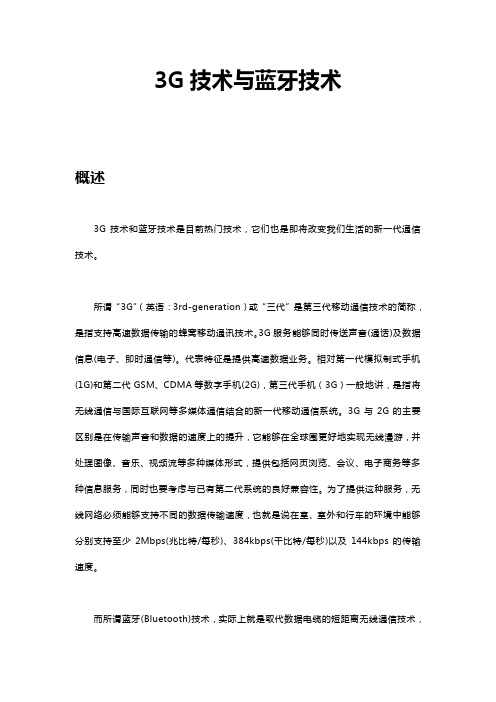
3G技术与蓝牙技术概述3G技术和蓝牙技术是目前热门技术,它们也是即将改变我们生活的新一代通信技术。
所谓“3G”(英语:3rd-generation)或“三代”是第三代移动通信技术的简称,是指支持高速数据传输的蜂窝移动通讯技术。
3G服务能够同时传送声音(通话)及数据信息(电子、即时通信等)。
代表特征是提供高速数据业务。
相对第一代模拟制式手机(1G)和第二代GSM、CDMA等数字手机(2G),第三代手机(3G)一般地讲,是指将无线通信与国际互联网等多媒体通信结合的新一代移动通信系统。
3G与2G的主要区别是在传输声音和数据的速度上的提升,它能够在全球围更好地实现无线漫游,并处理图像、音乐、视频流等多种媒体形式,提供包括网页浏览、会议、电子商务等多种信息服务,同时也要考虑与已有第二代系统的良好兼容性。
为了提供这种服务,无线网络必须能够支持不同的数据传输速度,也就是说在室、室外和行车的环境中能够分别支持至少2Mbps(兆比特/每秒)、384kbps(千比特/每秒)以及144kbps的传输速度。
而所谓蓝牙(Bluetooth)技术,实际上就是取代数据电缆的短距离无线通信技术,通过低带宽电波实现点对点,或点对多点连接之间的信息交流。
它是实现语音和数据无线传输的开放性规,是一种低成本、短距离的无线连接技术。
3G技术介绍3G技术标准一共有三种:它们分别是TD-SCDMA(中国版)、WCDMA(欧洲版)和CDMA2000(美国版)。
下面就分别介绍一下三种技术:TD-SCDMATD-SCDMA(Time Division-Synchronous Code Division Multiple Access),即时分同步的码分多址技术,是ITU正式发布的第三代移动通信空间接口技术规之一,也是中国制定的3G标准。
1999年6月29日,中国原邮电部电信科学技术研究院(现大唐电信)向ITU 提出了该标准。
该标准将智能天线、同步CDMA和软件无线电(SDR)等技术融于其中,可以减少用户间干扰,从而提高频谱利用率。
通信工程专业毕业论文参考文献
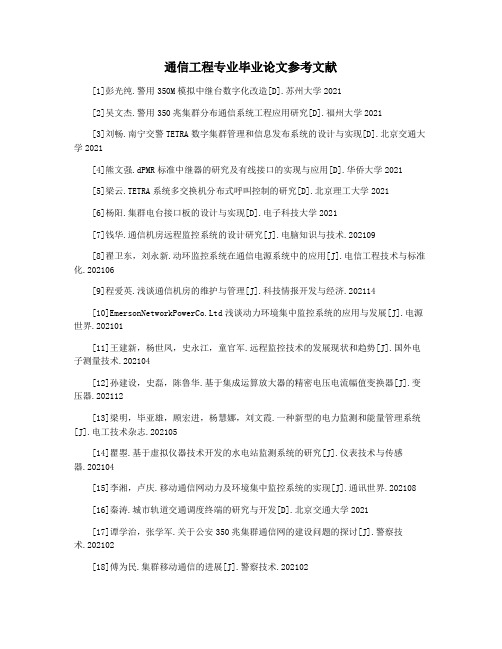
通信工程专业毕业论文参考文献[1]彭光纯.警用350M模拟中继台数字化改造[D].苏州大学2021[2]吴文杰.警用350兆集群分布通信系统工程应用研究[D].福州大学2021[3]刘畅.南宁交警TETRA数字集群管理和信息发布系统的设计与实现[D].北京交通大学2021[4]熊文强.dPMR标准中继器的研究及有线接口的实现与应用[D].华侨大学2021[5]梁云.TETRA系统多交换机分布式呼叫控制的研究[D].北京理工大学2021[6]杨阳.集群电台接口板的设计与实现[D].电子科技大学2021[7]钱华.通信机房远程监控系统的设计研究[J].电脑知识与技术.202109[8]翟卫东,刘永新.动环监控系统在通信电源系统中的应用[J].电信工程技术与标准化.202106[9]程爱英.浅谈通信机房的维护与管理[J].科技情报开发与经济.202114[10]EmersonNetworkPowerCo.Ltd浅谈动力环境集中监控系统的应用与发展[J].电源世界.202101[11]王建新,杨世凤,史永江,童官军.远程监控技术的发展现状和趋势[J].国外电子测量技术.202104[12]孙建设,史磊,陈鲁华.基于集成运算放大器的精密电压电流幅值变换器[J].变压器.202112[13]梁明,毕亚雄,顾宏进,杨慧娜,刘文霞.一种新型的电力监测和能量管理系统[J].电工技术杂志.202105[14]瞿曌.基于虚拟仪器技术开发的水电站监测系统的研究[J].仪表技术与传感器.202104[15]李湘,卢庆.移动通信网动力及环境集中监控系统的实现[J].通讯世界.202108[16]秦涛.城市轨道交通调度终端的研究与开发[D].北京交通大学2021[17]谭学治,张学军.关于公安350兆集群通信网的建设问题的探讨[J].警察技术.202102[18]傅为民.集群移动通信的进展[J].警察技术.202102[19]王为民,符东昇.MPT1327集群通信系统无线链路联网技术及应用[J].警察技术.202106[20]程效军,徐文昌.公安应急指挥系统中关键技术的探讨[J].同济大学学报自然科学版.202101[21]李鸿,胡少鹏.数字集群通信系统及其在公安系统中的应用[J].广东公安科技.200204[1]王钦.基于ZigBee无线传感器网络的研究与应用[D].福州大学2021[2]黄凌霄.电力线扩频接收系统的研究与实现[D].福州大学2021[3]陈大平.基于时频分析的BFSK信号解调的研究和实现[D].福州大学2021[4]徐子平.公安集群通信系统基站间IP互连技术概述[J].警察技术.202106[5]贾丹,刘建伟.公安无线通信系统发展展望--MPT集群分布通信系统[J].警察技术.202102[6]徐子平.公安集群通信系统基站间IP互连技术概述[J].警察技术.202106[7]贾丹,刘建伟.公安无线通信系统发展展望--MPT集群分布通信系统[J].警察技术.202102[8]奚雯佳.基于TETRA的专用无线通信系统在城市轨道交通中的应用[D].南京邮电大学2021[9]钟红艳.基于认知无线电AdHoc网络的多用户接入及通信调度的研究[D].南京邮电大学2021[10]闫思思.DMR数字集群基带传输关键技术的研究与实现[D].天津大学2021[11]彭光纯.警用350M模拟中继台数字化改造[D].苏州大学2021[12]吴文杰.警用350兆集群分布通信系统工程应用研究[D].福州大学2021[13]刘畅.南宁交警TETRA数字集群管理和信息发布系统的设计与实现[D].北京交通大学2021[14]熊文强.dPMR标准中继器的研究及有线接口的实现与应用[D].华侨大学2021[15]李军.350兆无线集群通信系统的原理、结构及维护[J].警察技术.202101[16]谭学治,张学军.关于公安350兆集群通信网的建设问题的探讨[J].警察技术.202102[17]傅为民.集群移动通信的进展[J].警察技术.202102[18]王为民,符东昇.MPT1327集群通信系统无线链路联网技术及应用[J].警察技术.202106[19]程效军,徐文昌.公安应急指挥系统中关键技术的探讨[J].同济大学学报自然科学版.202101[20]李鸿,胡少鹏.数字集群通信系统及其在公安系统中的应用[J].广东公安科技.200204[21]李军.350兆无线集群通信系统的原理、结构及维护[J].警察技术.202101[1]谢显中,聂能.3G手机不再神秘[J].数字通信.200010[2]谢显中,李颖,吴克颖,王新梅.Turbo码与空时编码的结合研究及其性能[J].西安电子科技大学学报.200106[3]刘正军,蔡国权,罗小武.DS-CDMA系统中一种盲2-DRAKE接收机的研究[J].电子学报.1999S1[4]葛利嘉,路鸣.蜂窝通信的空分多址:概念、算法和性能[J].通信学报.199908[5]谢显中,柏春燕,王新梅.神经网络技术在纠错码研究中的现状与前景[J].西安电子科技大学学报.199903[6]柏春燕,谢显中,王新梅.基于前馈神经网络的分组码译码方案[J].西安电子科技大学学报.199902[7]谢显中,王新梅.第三代移动通信系统的空中接口方案[J].移动通信.199901[8]谢显中,苗洪雷,李颖,王新梅.分层空时码的模型、译码接收及其性能仿真[J].通信学报.200108[9]蒋伯峰,王文杰,殷勤业.利用波达方向矩阵法实现多径信道方向角与相对时延的联合估计[J].电子学报.1999S1[10]金梁,汪仪林,殷勤业.多用户环境下阵列响应的闭式盲估计方法[J].电子学报.199912[11]谢显中.TDD模式与第三代移动通信系统[J].现代电信科技.200002[12]郑元谨,闻懋生.基于神经网络的23,12Golay码译码新算法[J].通信技术.199602[13]殷贯西.移动卫星信道中的数字传输[D].西安电子科技大学1998[14]田斌.实用化汉语语音识别理论及关键技术研究[D].西安电子科技大学1999[15]白宝明.Turbo码理论及其应用的研究[D].西安电子科技大学1999感谢您的阅读,祝您生活愉快。
lora无线通信技术论文

lora无线通信技术论文无线通信是利用电磁波信号可以在自由空间中传播的特性进行信息交换的一种通信方式,下面是店铺整理的lora无线通信技术论文,希望你能从中得到感悟!lora无线通信技术论文篇一近代无线通信技术【摘要】越来越多数字电子产品借着新科技提升本身的性能和实力。
以目前发展的趋势来看,未来消费性电子产品将有两个重要的发展指标,一是使用蓝牙技术这类开放技术,以无线,局域网络,可携带式设备成为网络体的延伸。
另一项则是内存规格的统一,加密以及轻量化应用。
蓝牙(Bluetooth)最初的设计目标是取代现有的掌上电脑、移动电话等各种数字设备上的有线电缆连接无论您喜与否,“蓝牙计划”这个名词几乎已经无孔不入,不论是商业财经台还是一般大众电视台,都不只一次报导过蓝牙相关继续和这个计划的进展。
但很少人了解“蓝牙计划”的原意与来龙去脉,只知道有这样一个计划正如火如荼地进行,且声势浩大、似乎充满无限希望。
【关键词】蓝牙(Bluetooth);近距离无线通信1.蓝牙的起源与发展蓝牙是1998年5月由东芝、爱立信、IBM、Intel和诺基亚共同提出的一种近距离无线数据通讯的技术标准,这是一种支持设备短距离通信的无线电技术。
利用该技术可以有效地简化移动通信终端设备之间的通信,也能够成功地简化设备与因特网之间的通信,使数据的传输变得更加迅速、高效。
蓝牙的支持者从最初的五家企业发起的蓝牙特别兴趣小组(SIG)发展到现在近3000个企业成员。
蓝牙从实验室进入市场要经过三个阶段:第一阶段(2001年底到2002底):蓝牙产品作为附件应用于移动性较大的高端产品(如移动电话耳机、笔记本电脑插卡或PC卡等)中,或应用于只要求性能和功能且对价格无要求的特殊场合。
第二阶段(2002年到2005年):蓝牙产品嵌入中高档产品中,如PDA、移动电话、PC、笔记本电脑等。
蓝牙的价格进一步下降,估计其芯片价格在10美元左右,而有关的测试和认证工作也初步完善。
计算机网络中英文对照外文翻译文献
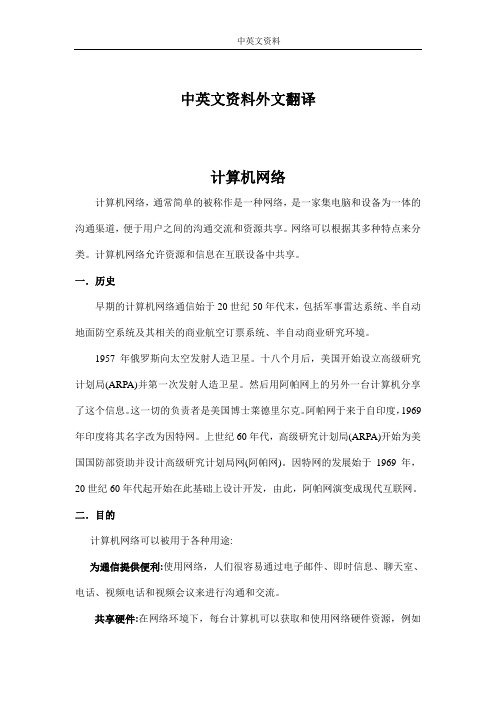
中英文资料外文翻译计算机网络计算机网络,通常简单的被称作是一种网络,是一家集电脑和设备为一体的沟通渠道,便于用户之间的沟通交流和资源共享。
网络可以根据其多种特点来分类。
计算机网络允许资源和信息在互联设备中共享。
一.历史早期的计算机网络通信始于20世纪50年代末,包括军事雷达系统、半自动地面防空系统及其相关的商业航空订票系统、半自动商业研究环境。
1957年俄罗斯向太空发射人造卫星。
十八个月后,美国开始设立高级研究计划局(ARPA)并第一次发射人造卫星。
然后用阿帕网上的另外一台计算机分享了这个信息。
这一切的负责者是美国博士莱德里尔克。
阿帕网于来于自印度,1969年印度将其名字改为因特网。
上世纪60年代,高级研究计划局(ARPA)开始为美国国防部资助并设计高级研究计划局网(阿帕网)。
因特网的发展始于1969年,20世纪60年代起开始在此基础上设计开发,由此,阿帕网演变成现代互联网。
二.目的计算机网络可以被用于各种用途:为通信提供便利:使用网络,人们很容易通过电子邮件、即时信息、聊天室、电话、视频电话和视频会议来进行沟通和交流。
共享硬件:在网络环境下,每台计算机可以获取和使用网络硬件资源,例如打印一份文件可以通过网络打印机。
共享文件:数据和信息: 在网络环境中,授权用户可以访问存储在其他计算机上的网络数据和信息。
提供进入数据和信息共享存储设备的能力是许多网络的一个重要特征。
共享软件:用户可以连接到远程计算机的网络应用程序。
信息保存。
安全保证。
三.网络分类下面的列表显示用于网络分类:3.1连接方式计算机网络可以据硬件和软件技术分为用来连接个人设备的网络,如:光纤、局域网、无线局域网、家用网络设备、电缆通讯和G.hn(有线家庭网络标准)等等。
以太网的定义,它是由IEEE 802标准,并利用各种媒介,使设备之间进行通信的网络。
经常部署的设备包括网络集线器、交换机、网桥、路由器。
无线局域网技术是使用无线设备进行连接的。
5G无线通信网络中英文对照外文翻译文献

5G无线通信网络中英文对照外文翻译文献(文档含英文原文和中文翻译)翻译:5G无线通信网络的蜂窝结构和关键技术摘要第四代无线通信系统已经或者即将在许多国家部署。
然而,随着无线移动设备和服务的激增,仍然有一些挑战尤其是4G所不能容纳的,例如像频谱危机和高能量消耗。
无线系统设计师们面临着满足新型无线应用对高数据速率和机动性要求的持续性增长的需求,因此他们已经开始研究被期望于2020年后就能部署的第五代无线系统。
在这篇文章里面,我们提出一个有内门和外门情景之分的潜在的蜂窝结构,并且讨论了多种可行性关于5G无线通信系统的技术,比如大量的MIMO技术,节能通信,认知的广播网络和可见光通信。
面临潜在技术的未知挑战也被讨论了。
介绍信息通信技术(ICT)创新合理的使用对世界经济的提高变得越来越重要。
无线通信网络在全球ICT战略中也许是最挑剔的元素,并且支撑着很多其他的行业,它是世界上成长最快最有活力的行业之一。
欧洲移动天文台(EMO)报道2010年移动通信业总计税收1740亿欧元,从而超过了航空航天业和制药业。
无线技术的发展大大提高了人们在商业运作和社交功能方面通信和生活的能力无线移动通信的显著成就表现在技术创新的快速步伐。
从1991年二代移动通信系统(2G)的初次登场到2001年三代系统(3G)的首次起飞,无线移动网络已经实现了从一个纯粹的技术系统到一个能承载大量多媒体内容网络的转变。
4G无线系统被设计出来用来满足IMT-A技术使用IP面向所有服务的需求。
在4G系统中,先进的无线接口被用于正交频分复用技术(OFDM),多输入多输出系统(MIMO)和链路自适应技术。
4G无线网络可支持数据速率可达1Gb/s的低流度,比如流动局域无线访问,还有速率高达100M/s的高流速,例如像移动访问。
LTE系统和它的延伸系统LTE-A,作为实用的4G系统已经在全球于最近期或不久的将来部署。
然而,每年仍然有戏剧性增长数量的用户支持移动宽频带系统。
(完整版)数字信号处理英文文献及翻译
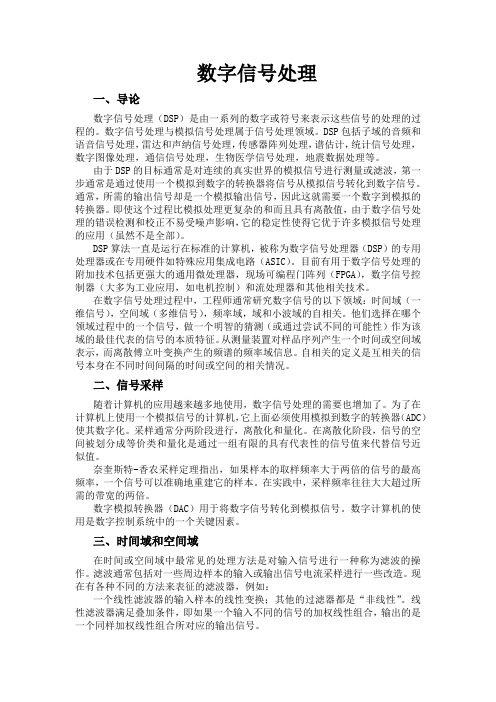
数字信号处理一、导论数字信号处理(DSP)是由一系列的数字或符号来表示这些信号的处理的过程的。
数字信号处理与模拟信号处理属于信号处理领域。
DSP包括子域的音频和语音信号处理,雷达和声纳信号处理,传感器阵列处理,谱估计,统计信号处理,数字图像处理,通信信号处理,生物医学信号处理,地震数据处理等。
由于DSP的目标通常是对连续的真实世界的模拟信号进行测量或滤波,第一步通常是通过使用一个模拟到数字的转换器将信号从模拟信号转化到数字信号。
通常,所需的输出信号却是一个模拟输出信号,因此这就需要一个数字到模拟的转换器。
即使这个过程比模拟处理更复杂的和而且具有离散值,由于数字信号处理的错误检测和校正不易受噪声影响,它的稳定性使得它优于许多模拟信号处理的应用(虽然不是全部)。
DSP算法一直是运行在标准的计算机,被称为数字信号处理器(DSP)的专用处理器或在专用硬件如特殊应用集成电路(ASIC)。
目前有用于数字信号处理的附加技术包括更强大的通用微处理器,现场可编程门阵列(FPGA),数字信号控制器(大多为工业应用,如电机控制)和流处理器和其他相关技术。
在数字信号处理过程中,工程师通常研究数字信号的以下领域:时间域(一维信号),空间域(多维信号),频率域,域和小波域的自相关。
他们选择在哪个领域过程中的一个信号,做一个明智的猜测(或通过尝试不同的可能性)作为该域的最佳代表的信号的本质特征。
从测量装置对样品序列产生一个时间或空间域表示,而离散傅立叶变换产生的频谱的频率域信息。
自相关的定义是互相关的信号本身在不同时间间隔的时间或空间的相关情况。
二、信号采样随着计算机的应用越来越多地使用,数字信号处理的需要也增加了。
为了在计算机上使用一个模拟信号的计算机,它上面必须使用模拟到数字的转换器(ADC)使其数字化。
采样通常分两阶段进行,离散化和量化。
在离散化阶段,信号的空间被划分成等价类和量化是通过一组有限的具有代表性的信号值来代替信号近似值。
通信类外文文献翻译
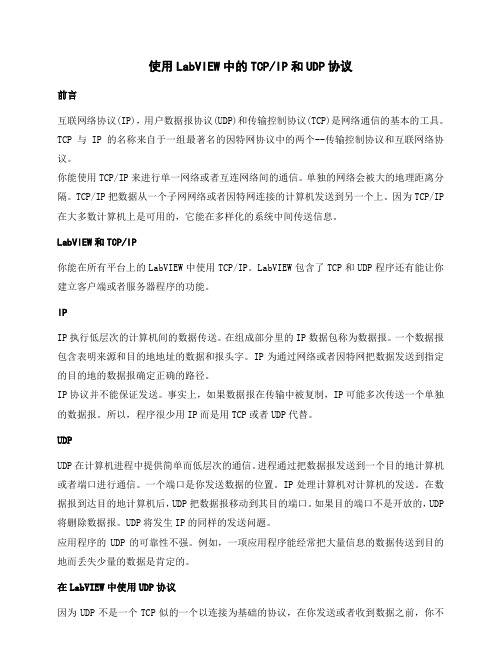
使用LabVIEW中的TCP/IP和UDP协议前言互联网络协议(IP),用户数据报协议(UDP)和传输控制协议(TCP)是网络通信的基本的工具。
TCP与IP的名称来自于一组最著名的因特网协议中的两个--传输控制协议和互联网络协议。
你能使用TCP/IP来进行单一网络或者互连网络间的通信。
单独的网络会被大的地理距离分隔。
TCP/IP把数据从一个子网网络或者因特网连接的计算机发送到另一个上。
因为TCP/IP 在大多数计算机上是可用的,它能在多样化的系统中间传送信息。
LabVIEW和TCP/IP你能在所有平台上的LabVIEW中使用TCP/IP。
LabVIEW包含了TCP和UDP程序还有能让你建立客户端或者服务器程序的功能。
IPIP执行低层次的计算机间的数据传送。
在组成部分里的IP数据包称为数据报。
一个数据报包含表明来源和目的地地址的数据和报头字。
IP为通过网络或者因特网把数据发送到指定的目的地的数据报确定正确的路径。
IP协议并不能保证发送。
事实上,如果数据报在传输中被复制,IP可能多次传送一个单独的数据报。
所以,程序很少用IP而是用TCP或者UDP代替。
UDPUDP在计算机进程中提供简单而低层次的通信。
进程通过把数据报发送到一个目的地计算机或者端口进行通信。
一个端口是你发送数据的位置。
IP处理计算机对计算机的发送。
在数据报到达目的地计算机后,UDP把数据报移动到其目的端口。
如果目的端口不是开放的,UDP 将删除数据报。
UDP将发生IP的同样的发送问题。
应用程序的UDP的可靠性不强。
例如,一项应用程序能经常把大量信息的数据传送到目的地而丢失少量的数据是肯定的。
在LabVIEW中使用UDP协议因为UDP不是一个TCP似的一个以连接为基础的协议,在你发送或者收到数据之前,你不需要和目的地建立一种连接。
相反,当你每发送一个数据报时,由你指定数据目的地。
操作系统不会报告传输差错使用UDP打开功能在一个端口上打开一个UDP插口。
英文文献025:手机发展趋势

外文翻译:手机发展趋势随着电子技术的不断发展,数码产品越来越贴近人们的生活。
随之而来的是人们不断追求更多的便捷的享受,更多娱乐气氛。
十年前手机仅仅作为一个通讯设备出现在人们的面前,但是在网络全球化的今天,手机俨然成为个人的“超级计算机”,品种多样的手机,纷乱复杂的程序软件,不断改变人们手机使用的态度,也不断催生人们的好奇心。
手机在这么多的苛刻标准和日新月异的技术创新中,该何去何从。
手机产业链的变化该怎么满足不断增长的好奇心和挑剔。
更多原创经管论文及英文文献与翻译请访问:http://经管论文.com/ ,并提供定制服务目前手机的不能满足人们的需求,当今的人们被手机束缚着,牢牢的把人们困在一个人为的模式下,手机功能不能是无限的,但是手机发展并不仅于此。
所以不断骚动的人们破解,研发,改装等等想改变这样的局面。
但这只是从量的角度积累想通过这个达到质的飞跃,同时必须要有把握未来趋势的洞察力和掌控力。
手机的发展要同社会的发展相适应,以后的手机将成为人们的不可或缺的智能机器。
手机未来的七大发展趋势1、未来手机发展总体趋势就是硬件提升和软件开发?现在手机的用途很大部分用于通信,包括电话、短信、彩信、网页、QQ等等。
但这只是手机内部或者说是手机产业内部模式化的服务。
硬件提升和软件开发仅仅是手机未来发展的先决条件。
手机的发展不仅仅是手机单方面的,是多个方面的发展。
比如:手机将可能成为虚拟货币流通渠道,这就需要运营商等等行业的支持。
手机可能出现虚拟人物,这就需要媒体等行业的支持。
手机有可能内置其他类别的设备的,比如:医疗,测距,夜视等等就需要很多行业的支持。
手机将会慢慢发展两大趋势:一是普遍智能化,一是专业智能化。
这很可能衍生出普通手机用途和专业人士的特殊用途的两种或几种类型来逐步满足人们的需要。
总之,未来的手机将更加的虚拟化和人性化,当然还会很智能化。
2、未来手机的平台能不能够统一?现在很多手机是基于不同平台运行的,各种操作系统各有千秋。
英文文献翻译1.
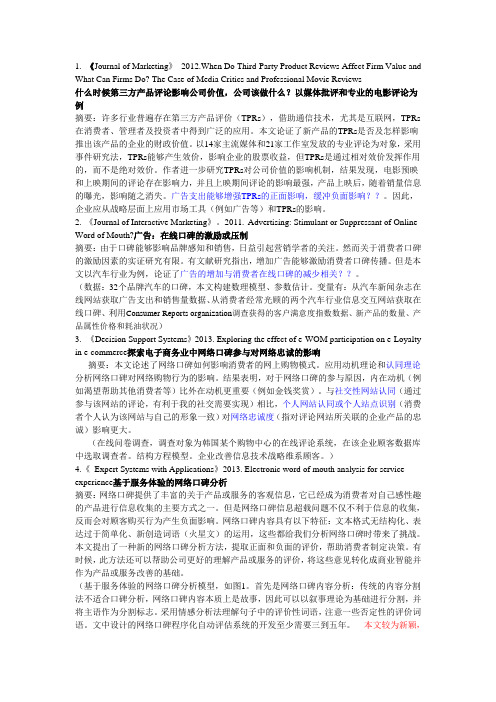
1.《Journal of Marketing》2012.When Do Third-Party Product Reviews Affect Firm Value and What Can Firms Do? The Case of Media Critics and Professional Movie Reviews什么时候第三方产品评论影响公司价值,公司该做什么?以媒体批评和专业的电影评论为例摘要:许多行业普遍存在第三方产品评价(TPRs),借助通信技术,尤其是互联网,TPRs 在消费者、管理者及投资者中得到广泛的应用。
本文论证了新产品的TPRs是否及怎样影响推出该产品的企业的财政价值。
以14家主流媒体和21家工作室发放的专业评论为对象,采用事件研究法,TPRs能够产生效价,影响企业的股票收益,但TPRs是通过相对效价发挥作用的,而不是绝对效价。
作者进一步研究TPRs对公司价值的影响机制,结果发现,电影预映和上映期间的评论存在影响力,并且上映期间评论的影响最强,产品上映后,随着销量信息的曝光,影响随之消失。
广告支出能够增强TPRs的正面影响,缓冲负面影响??。
因此,企业应从战略层面上应用市场工具(例如广告等)和TPRs的影响。
2.《Journal of Interactive Marketing》。
2011.Advertising: Stimulant or Suppressant of Online Word of Mouth?广告:在线口碑的激励或压制摘要:由于口碑能够影响品牌感知和销售,日益引起营销学者的关注。
然而关于消费者口碑的激励因素的实证研究有限。
有文献研究指出,增加广告能够激励消费者口碑传播。
但是本文以汽车行业为例,论证了广告的增加与消费者在线口碑的减少相关??。
(数据:32个品牌汽车的口碑,本文构建数理模型、参数估计。
变量有:从汽车新闻杂志在线网站获取广告支出和销售量数据、从消费者经常光顾的两个汽车行业信息交互网站获取在线口碑、利用Consumer Reports organization调查获得的客户满意度指数数据、新产品的数量、产品属性价格和耗油状况)3.《Decision Support Systems》2013. Exploring the effect of e-WOM participation on e-Loyalty in e-commerce探索电子商务业中网络口碑参与对网络忠诚的影响摘要:本文论述了网络口碑如何影响消费者的网上购物模式。
英文科技文献翻译

英文文献翻译二〇一二年五月三十日Integrated wiring systemModern science and technology progress has made rapid development of computer and network technology, provides a more powerful computer processing capacity and network communication ability. The computer and network communication technology can greatly improve the modern enterprise production management efficiency, reduce the operation cost, and makes the modern enterprise can obtain more effectively and timely decision market information, provide more quickly, more satisfactory service to customers, in the competition. The computer and network communication technology has become a key factor in the success of the company.Integrated cabling system in order to meet the development needs is specially designed a set of cabling system. For modern buildings, such as the body, it adopted a series of nerve of high quality standard, modular combinations of material, the voice, data and image and control signal system using uniform transmission media, through comprehensive, integrated unified planning design in a set of standard cabling system in modern architecture, the three subsystems will connect organically, and system integration for the modern architecture provides a physical medium. Structured cabling system can directly related to the success of the modernization of the building, choose a high quality of integrated wiring system is of vital importance.Computer and communication networks are dependent on wiring system as the physical basis of network connections and information transmission channel. The traditional single application on a particular special layout techniques, lack of flexibility and development of, can not meet the rapid development of modern business needs of network applications. The new generation of structured cabling systems provide the user the required data, voice, fax, video and other information service connections, which allows voice and data communications equipment, switching equipment, information management systems and equipment control system , security system connected to each other, but also to make these devices with external communication networks. It includes the building to the external network or phone line connection Bureau,with the work area of voice or data terminals associated with all the cables and wiring components. Cabling system composed by different series of components, including: transmission media, line management of hardware, connectors, sockets, plugs, adapters, transmission electronic circuits, electrical protection equipment and support. Compared with the previous wiring, cabling system features can be summarized as:Practicality: after the implementation of cabling systems will be able to adapt to the modern and future communication technology development and implementation of voice, data, unified communications, signal transmission.Flexibility: wiring system can satisfy the requirements of various applications, information points to any connection of different types of terminal equipment, such as telephone, computer, printer, computer terminal, electric machine, various sensors and image monitoring equipment.Modularity: integrated cabling system in fixed in buildings, the level of all cable connectors are basic type of the standard, all voice, data and interconnection of building automation, network and image, with convenient use, equipment, change, management and expansion.Scalability: integrated wiring system is for future expansion, more use, easy to expand into new equipment.Economy: the integrated wiring system enables managers, and at the same time, reduce the modular structure, work because of the difficulty of future changes greatly reduced the cost or moving system.General: to meet the standard of international communication and computer network topology structure, can adapt different transmission speed communication can adapt to the requirement, can support and accommodate various computer network operation.1 workspace subsystemPurpose is to realize the workspace terminal equipment and level of connections between subsystems, the terminal devices connected to the information socket connection cables. Workspace used computer, networkequipment is distributed (on), telephone, or may alarm detector, camera, monitors, acoustics, etc.2 Horizontal subsystemPurpose is to realize information socket and management subsystem (jumper wire connection between frame), will lead to the management subsystem of user workspace, and to provide users with one accord with international standard pronunciation, satisfy the requirements and the high-speed data transmission information points. The subsystem of information from a job, decorate the socket to the inside of the administrative levels of the cable distribution frames. In the system of transmission medium of UTP (4) shielding twisted-pair cable, it can support the most modern communication equipment. If you need some broadband application, you can use fiber. Information ISDN8 for export by core RJ45 jack (standard), each information socket outlets can be flexibly according to actual application requirements and optional change purposes.3 the management subsystemThis sub-system connected by a cross, composed of interconnect patch panel. Management point of connection means to connect to other subsystems. Cross-connect and interconnect allows communication lines locate or relocate to different parts of the building to make it easier to manage communication lines, so that when the mobile terminal device easily plug. Interconnection distribution frame connections under different hardware sub-floor distribution frame (box) IDF and MDF (box) MDF, IDF can be installed on each floor of the trunk connection between, MDF is usually installed in the equipment room.4 vertical lines subsystemPurpose is to achieve the computer equipment, pabx (PBX), with the management subsystem of control center is building a connection between the main cable, routing. This is usually between two units subsystem, especially in the central point in the public system provides more line facilities. By building the system all vertical lines and more logarithmic cable support hardware, toprovide total distribution frames and main equipment room wiring between floors between the main distribution frames routing. Common medium is multi-cores cable and optical fiber cable twisted-pair.5.Equipment room subsystemThis subsystem is mainly from the devices in the cable, connectors and related hardware support, the role of the computer, PBX, cameras, monitors and other weak and connected to the interconnection of equipment up on the main distribution frame. Equipment includes computer systems, network hub (Hub), network switches (Switch), program-controlled switchboards (PBX), audio output devices, CCTV control devices and alarm control center, etc.6 Buildings subsystem (Campus):The subsystem will be extended to cable a building complex of other buildings of the communications equipment and devices, is part of a structured cabling system to support the provision of buildings in the hardware required for communication between. It consists of cables, fiber optic cable and into the Building Department, over-current over-voltage protection equipment and other related electrical hardware, commonly used medium is optical fiber. Compared with the traditional routing, integrated wiring construction as a modern information transmission system, its main advantages are: Traditional wiring specification due to lack of a unified, user must choose a variety of different application types of cables, connectors and wiring, resulting in duplication of cable laying waste, lack of flexibility and can not support the development needs of the user application re-wiring; integrated wiring system integration requirements of modern architecture transmission of voice, data, video and other information, using international standardized information interface and performance specifications, to support multi-vendor equipment and protocols to meet the rapid development of modern enterprise information application needs.Integrated wiring system, the user can according to actual needs or changing office environment, flexible and convenient way to achieve change and restructuring routes, adjusting the mode of building the network required to fully meet user business needs.Structured cabling system is the star topology wiring methods and standard interfaces, which greatly improves over all network reliability and manageability, significantly reduce system management and maintenance costs. The modular system design to provide a good system scalability and future-oriented application development support, fully guaranteed the user's investment in cabling, providing customers a long-term benefits.Cabling System can solve the traditional wiring methods exist many problems, provides long-term benefits of advanced and reliable solutions. With the rapid development of modern information technology, integrated wiring system will be indispensable to modern intelligent building infrastructure.综合布线系统现代科技的进步使计算机及网络技术飞速发展,提供越来越强大的计算机处理能力和网络通信能力。
计算机第五代5g移动通讯通信技术介绍简介概述外文文献翻译成品:5G的五个颠覆性技术方向中英文双语对照

Five Disruptive Technology Directions for 5G ABSTRACT: New research directions will lead to fundamental changes in the design of future 5th generation (5G) cellular networks. This paper describes five technologies that could lead to both architectural and component disruptive design changes: device-centric architectures, millimeter Wave, Massive-MIMO, smarter devices, and native support to machine-2-machine. The key ideas for each technology are described, along with their potential impact on 5G and the research challenges that remain.I.INTRODUCTION:5G is coming. What technologies will define it? Will 5G be just an evolution of 4G, or will emerging technologies cause a disruption requiring a wholesale rethinking of entrenched cellular principles? This paper focuses on potential disruptive technologies and their implications for 5G. We classify the impact of new technologies, leveraging the Henderson-Clark model [1], as follows:1.Minor changes at both the node and the architectural level, e.g., the introduction of codebooks and signaling support for a higher number of antennas. We refer to these as evolutions in the design.2.Disruptive changes in the design of a class of network nodes, e.g., the introduction of a new waveform. We refer to these as component changes.3.Disruptive changes in the system architecture, e.g., the introduction of new types of nodes or new functions in existing ones. We refer to these as architectural changes.4.Disruptive changes that have an impact at both the node and the architecture levels. We refer to these as radical changes.We focus on disruptive (component, architectural or radical) technologies, driven by our belief that the extremely higher aggregate data rates and the much lower latencies required by 5G cannot be achieved with a mere evolution of the status quo. We believe that the following five potentially disruptive technologies could lead to both architectural and component design changes, as classified in Figure 1.1.Device-centric architectures.The base-station-centric architecture of cellular systems may change in 5G. It may be time to reconsider the concepts of uplink and downlink, as well as control and data channels, to better route information flows with different priorities and purposes towards different sets of nodes within the network. We present device-centric architectures in Section II.limeter Wave (mmWave).While spectrum has become scarce at microwave frequencies, it is plentiful in the mmWave realm. Such a spectrum ‘el Dorado’ has led to a mmWave ‘gold rush’ in which researchers with diverse backgrounds are studying different aspects ofmmWave transmission. Although far from fully understood, mmWave technologies have already been standardized for short-range services (IEEE 802.11ad) and deployed for niche applications such as small-cell backhaul. In Section III, we discuss the potential of mmWave for a broader application in 5G.3.Massive-MIMO.Massive-MIMO1 proposes utilizing a very high number of antennas to multiplex messages for several devices on each time-frequency resource, focusing the radiated energy towards the intended directions while minimizing intra-and inter-cell interference. Massive-MIMO may require major architectural changes, in particular in the design of macro base stations, and it may also lead to new types of deployments. We discuss massive-MIMO in Section IV.4.Smarter devices.2G-3G-4G cellular networks were built under the design premise of having complete control at the infrastructure side. We argue that 5G systems should drop this design assumption and exploit intelligence at the device side within different layers of the protocol stack, e.g., by allowing Device-to-Device (D2D) connectivity or by exploiting smart caching at the mobile side. While this design philosophy mainly requires a change at the node level (component change), it has also implications at the architectural level. We argue for smarter devices in Section V.5.Native support for Machine-to-Machine (M2M) communicationA native2 inclusion of M2M communication in 5G involves satisfying three fundamentally different requirements associated to different classes of low-data-rate services: support of a massive number of low-rate devices, sustainment of a minimal data rate in virtually all circumstances, and very-low-latency data transfer. Addressing these requirements in 5G requires new methods and ideas at both the component and architectural level, and such is the focus of Section VI.II.DEVICE-CENTRIC ARCHITECTURESCellular designs have historically relied on the axiomatic role of ‘cells’ as fundamental units within the radio access network. Under such a design postulate, a device obtains service by establishing a downlink and an uplink connection, carrying both control and data traffic, with the base station commanding the cell where the device is located. Over the last few years, different trends have been pointing to a disruption of this cell-centric structure:1.The base-station density is increasing rapidly, driven by the rise of heterogeneous networks. While heterogeneous networks were already standardized in 4G, the architecture was not natively designed to support them. Network densification could require some major changes in 5G. The deployment of base stations with vastly different transmit powers and coverage areas, for instance, calls for a decoupling of downlink and uplink in a way that allows for the corresponding information to flow through different sets of nodes [5].2.The need for additional spectrum will inevitably lead to the coexistence of frequency bands with radically different propagation characteristics within the same system. In this context, [6] proposes the concept of a ‘phantom cell’ where the data and control planes are separated: the control information is sent by high-power nodes at microwave frequencies whereas the payload data is conveyed by low-power nodes at mm-Wave frequencies. (cf. Section III.)3.A new concept termed centralized baseband related to the concept of cloud radioaccess networks is emerging (cf. [7]), where virtualization leads to a decoupling between a node and the hardware allocated to handle the processing associated with this node. Hardware resources in a pool, for instance, could be dynamically allocated to different nodes depending on metrics defined by the network operator.Emerging service classes, described in Section VI, could require a complete redefinition of the architecture. Current works are looking at architectural designs ranging from centralization or partial centralization (e.g., via aggregators) to full distribution (e.g., via compressed sensing and/or multihop).Cooperative communications paradigms such as CoMP or relaying, which despite falling short of their initial hype are nonetheless beneficial [8], could require a redefinition of the functions of the different nodes. In the context of relaying, for instance, recent developments in wireless network coding [9] suggest transmission principles that would allow recovering some of the losses associated with half-duplex relays. Moreover, recent research points to the plausibility of full- duplex nodes for short-range communication in a not-so-distant future.The use of smarter devices (cf. Section V) could impact the radio access network. In particular, both D2D and smart caching call for an architectural redefinition where the center of gravity moves from the network core to the periphery (devices, local wireless proxies, relays). Based on these trends, our vision is that the cell-centric architecture should evolve into a device-centric one: a given device (human or machine) should be able to communicate by exchanging multiple information flows through several possible sets of heterogeneous nodes. In other words, the set of network nodes providing connectivity to a given device and the functions of these nodes in a particular communication session should be tailored to that specific device and session. Under this vision, the concepts of uplink/downlink and control/data channel should be rethought (cf. Figure 2).While the need for a disruptive change in architectural design appears clear, major research efforts are still needed to transform the resulting vision into a coherent and realistic proposition. Since the history of innovations (cf. [1]) indicates that architectural changes are often the drivers of major technological discontinuities, we believe that the trends above might have a major influence on the development of 5G.LIMETER WA VE COMMUNICATIONMicrowave cellular systems have precious little spectrum: around 600 MHz are currently in use, divided among operators [10]. There are two ways to gain access to more microwave spectrum:1.To repurpose or refarm spectrum. This has occurred worldwide with the repurposing of terrestrial TV spectrum for applications such as rural broadband access. Unfortunately, repurposing has not freed up that much spectrum, only about 80 MHz, and at a high cost associated with moving the incumbents.2.To share spectrum utilizing, for instance, cognitive radio techniques. The high hopes initially placed on cognitive radio have been dampened by the fact that an incumbent not fully willing to cooperate is a major obstacle to spectrum efficiency for secondary users.3.Altogether, it appears that a doubling of the current cellular bandwidth is the best-case scenario at microwave frequencies. Alternatively, there is an enormous amount of spectrum at mmWave frequencies ranging from 3 to 300 GHz. Many bands therein seem promising, including most immediately the local multipoint distribution service at 28-30 GHz, the license-free band at 60 GHz, and the E-band at 71-76 GHz, 81-86 GHz and 92-95 GHz. Foreseeably, several tens of GHz could become available for 5G, offering well over an order-of-magnitude increase over what is available atpresent. Needless to say, work needs to be done on spectrum policy to render these bands available for mobile cellular.3.Propagation is not an insurmountable challenge. Recent measurements indicate similar general characteristics as at microwave frequencies, including distance-dependent pathloss and the possibility of non-line-of-sight communication. A main difference between microwave and mmWave frequencies is the sensitivity to blockages: the results in [11], for instance, indicate a pathloss exponent of 2 for line-of-sight propagation but 4 (plus an additional power loss) for non-line-of-sight. MmWave cellular research will need to incorporate sensitivity to blockages and more complex channel models into the analysis, and also study the effects of enablers such as higher density infrastructure and relays. Another enabler is the separation between control and data planes, already mentioned in Section II.Antenna arrays are a key feature in mmWave systems. Large arrays can be used to keep the antenna aperture constant, eliminating the frequency dependence of pathloss relative to omnidirectional antennas (when utilized at one side of the link) and providing a net array gain to counter the larger thermal noise bandwidth (when utilized at both sides of the link). Adaptive arrays with narrow beams also reduce the impact of interference, meaning that mmWave systems could more often operate in noise-limited rather than interference-limited conditions. Since meaningful communication might only happen under sufficient array gain, new random access protocols are needed that work when transmitters can only emit in certain directions and receivers can only receive from certain directions. Adaptive array processing algorithms are required that can adapt quickly when beams are blocked by people or when some device antennas become obscured by the user’s own body.MmWave systems also have distinct hardware constraints. A major one comes from the high power consumption of mixed signal components, chiefly the analog-to-digital (ADC) and digital-to-analog converters (DAC). Thus, the conventional microwave architecture where every antenna is connected to a high-rate ADC/DAC is unlikely to be applicable to mmWave without a huge leap forward in semiconductor technology. One alternative is a hybrid architecture where beamforming is performed in analog at RF and multiple sets of beamformers are connected to a small number of ADCs or DACS; in this alternative, signal processing algorithms are needed to steer the analog beamforming weights. Another alternative is to connect each RF chain to a 1-bit ADC/DAC, with very low power requirements; in this case, the beamforming would be performed digitally but on very noisy data. There are abundant research challenges in optimizing different transceiver strategies, analyzing their capacity, incorporating multiuser capabilities, and leveraging channel features such as sparsity.A data rate comparison between technologies is provided in Fig. 3, for certain simulation settings, in terms of mean and 5% outage rates. MmWave operation is seento provide very high rates compared to two different microwave systems. The gains exceed the 10x spectrum increase because of the enhanced signal power and reduced interference thanks to directional beamforming at both transmitter and receiver.IV.MASSIVE MIMOMassive MIMO (also referred to as ‘Large-Scale MIMO’ or ‘Large-Scale Antenna Systems’) is a form of multiuser MIMO in which the number of antennas at the base station is much larger than the number of devices per signaling resource [14]. Having many more base station antennas than devices renders the channels to the different devices quasi-orthogonal and very simple spatial multiplexing/de-multiplexing procedures quasi-optimal. The favorable action of the law of large numbers smoothens out frequency dependencies in the channel and, altogether, huge gains in spectral efficiency can be attained (cf. Fig. 4).In the context of the Henderson-Clark framework, we argue that massive-MIMO has a disruptive potential for 5G:At a node level, it is a scalable technology. This is in contrast with 4G, which, in many respects, is not scalable: further sectorization therein is not feasible because of (i) the limited space for bulky azimuthally-directive antennas, and (ii) the inevitable angle spread of the propagation; in turn, single-user MIMO is constrained by the limited number of antennas that can fit in certain mobile devices. In contrast, there is almost no limit on the number of base station antennas in massive- MIMO provided that time-division duplexing is employed to enable channel estimation through uplink pilots.It enables new deployments and architectures. While one can envision direct replacement of macro base stations with arrays of low-gain resonant antennas, other deployments are possible, e.g., conformal arrays on the facades of skyscrapers or arrays on the faces of water tanks in rural locations. Moreover, the same massive-MIMO principles that govern the use of collocated arrays of antennas applyalso to distributed deployments in which a college campus or an entire city could be covered with a multitude of distributed antennas that collectively serve many users (in this framework, the centralized baseband concept presented in Section II is an important architectural enabler).While very promising, massive-MIMO still presents a number of research challenges. Channel estimation is critical and currently it represents the main source of limitations. User motion imposes a finite coherence interval during which channel knowledge must be acquired and utilized, and consequently there is a finite number of orthogonal pilot sequences that can be assigned to the devices. Reuse of pilot sequences causes pilot contamination and coherent interference, which grows with the number of antennas as fast as the desired signals. The mitigation of pilot contamination is an active research topic. Also, there is still much to be learned about massive-MIMO propagation, although experiments thus far support the hypothesis of channel quasi-orthogonality. From an implementation perspective, massive-MIMO can potentially be realized with modular low-cost low-power hardware with each antenna functioning semi-autonomously, but a considerable development effort is still required to demonstrate the cost-effectiveness of this solution. Note that, at the microwave frequencies considered in this section, the cost and the energy consumption of ADCs/DACs are sensibly lower than at mmWave frequencies (cf. Section III).From the discussion above, we conclude that the adoption of massive-MIMO for 5G could represent a major leap with respect to today’s state-of-the-art in system and component design. To justify these major changes, massive-MIMO proponents should further work on solving the challenges emphasized above and on showing realistic performance improvements by means of theoretical studies, simulation campaigns, and testbed experiments.V.SMARTER DEVICESEarlier generations of cellular systems were built on the design premise of having complete control at the infrastructure side. In this section, we discuss some of the possibilities that can be unleashed by allowing the devices to play a more active role and, thereafter, how 5G’s design should account for an increase in device smartness. We focus on three different examples of technologies that could be incorporated into smarter devices, namely D2D, local caching, and advanced interference rejection.V.1 D2DIn voice-centric systems it was implicitly accepted that two parties willing to establish a call would not be in close proximity. In the age of data, this premise might no longer hold, and it could be common to have situations where several co-located devices would like to wirelessly share content (e.g., digital pictures) or interact (e.g., video gaming or social networking). Handling these communication scenarios via simply connecting through the network involves gross inefficiencies at various levels:1.Multiple wireless hops are utilized to achieve what requires, fundamentally, a single hop. This entails a multifold waste of signaling resources, and also a higher latency. Transmit powers of a fraction of a Watt (in the uplink) and several Watts (in the downlink) are consumed to achieve what requires, fundamentally, a few milliWatts. This, in turn, entails unnecessary levels of battery drain and of interference to all other devices occupying the same signaling resources elsewhere.2.Given that the pathlosses to possibly distant base stations are much stronger than the direct-link ones, the corresponding spectral efficiencies are also lower. While it is clear that D2D has the potential of handling local communication more efficiently, local high-data-rate exchanges could also be handled by other radio access technologies such as Bluetooth or Wi-Fi direct. Use cases requiring a mixture of local and nonlocal content or a mixture of low-latency and high- data-rate constraints (e.g., interaction between users via augmented reality), could represent more compelling reasons for the use of D2D. In particular, we envision D2D as an important enabler for applications requiring low-latency 3 , especially in future network deployments utilizing baseband centralization and radio virtualization (cf. Section I).From a research perspective, D2D communication presents relevant challenges:1.Quantification of the real opportunities for D2D. How often does local communication occur? What is the main use case for D2D: fast local exchanges, low-latency applications or energy saving?2.Integration of a D2D mode with the uplink/downlink duplexing structure.3.Design of D2D-enabled devices, from both a hardware and a protocol perspective, by providing the needed flexibility at both the PHY and MAC layers.4.Assessing the true net gains associated with having a D2D mode, accounting for possible extra overheads for control and channel estimation.5.Finally, note that, while D2D is already being studied in 3GPP as a 4G add-on2, the main focus of current studies is proximity detection for public safety [15]. What wediscussed here is having a D2D dimension natively supported in 5G.V.2 Local CachingThe current paradigm of cloud computing is the result of a progressive shift in the balance between data storage and data transfer: information is stored and processed wherever it is most convenient and inexpensive because the marginal cost of transferring it has become negligible, at least on wireline networks [2]. For wireless devices though, this cost is not always negligible. The understanding that mobile users are subject to sporadic ‘abundance’ of connectivity amidst stretches of ‘deprivation’ is hardly new, and the natural idea of opportunistically leveraging the former to alleviate the latter has been entertained since the 1990s [3]. However, this idea of caching massive amounts of data at the edge of the wireline network, right before the wireless hop, only applies to delay-tolerant traffic and thus it made little sense in voice-centric systems. Caching might finally make sense now, in data-centric systems [4]. Thinking ahead, it is easy to envision mobile devices with truly vast amounts of memory. Under this assumption, and given that a substantial share of the data that circulates wirelessly corresponds to the most popular audio/video/social content that is in vogue at a given time, it is clearly inefficient to transmit such content via unicast and yet it is frustratingly impossible to resort to multicast because the demand is asynchronous. We hence see local caching as an important alternative, both at the radio access network edge (e.g., at small cells) and at the mobile devices, also thanks to enablers such as mmWave and D2D.V.3 Advanced Interference RejectionIn addition to D2D capabilities and massive volumes of memory, future mobile devices may also have varying form factors. In some instances, the devices mightaccommodate several antennas with the consequent opportunity for active interference rejection therein, along with beamforming and spatial multiplexing. A joint design of transmitter and receiver processing, and proper control and pilot signals, are critical to allow advanced interference rejection. As an example, in Fig. 5 we show the gains obtained by incorporating the effects of nonlinear, intra and inter-cluster interference awareness into devices with 1, 2 and 4 antennas.While this section has been mainly focused on analyzing the implications of smarter devices at a component level, in Section II we discussed the impact at the radio access network architecture level. We regard smarter devices as having all the characteristic of a disruptive technology (cf. Section I) for 5G, and therefore we encourage researchers to further explore this direction.VI.NATIVE SUPPORT FOR M2M COMMUNICATIONWireless communication is becoming a commodity, just like electricity or water [13]. This commoditization, in turn, is giving rise to a large class of emerging services with new types of requirements. We point to a few representative such requirements, each exemplified by a typical service:1.A massive number of connected devices. Whereas current systems typically operate with, at most, a few hundred devices per base station, some M2M services might require over 104 connected devices. Examples include metering, sensors, smart grid components, and other enablers of services targeting wide area coverage.2.Very high link reliability. Systems geared at critical control, safety, or production, have been dominated by wireline connectivity largely because wireless links did not offer the same degree of confidence. As these systems transition from wireline to wireless, it becomes necessary for the wireless link to be reliably operational virtually all the time.3.Low latency and real-time operation. This can be an even more stringent requirement than the ones above, as it demands that data be transferred reliably within a given time interval. A typical example is Vehicle-to-X connectivity, whereby traffic safety can be improved through the timely delivery of critical messages (e.g., alert and control).Fig. 5 provides a perspective on the M2M requirements by plotting the data rate vs. the device population size. This cartoon illustrates where systems currently stand and how the research efforts are expanding them. The area R1 reflects the operating range of today’s systems, outlining the fact that the device data rate decreases as its population increases. In turn, R2 is the region that reflects current research aimed at improving the spectral efficiency. Finally, R5 indicates the region where operation is not feasible due to fundamental physical and information-theoretical limits.Regions R3 and R4 correspond to the emerging services discussed in this section:R3 refers to massive M2M communication where each connected machine or sensor transmits small data blocks sporadically. Current systems are not designed to simultaneously serve the aggregated traffic accrued from a large number of such devices. For instance, a current system could easily serve 5 devices at 2 Mbps each, but not 10000 devices each requiring 1 Kbps. R4 demarks the operation of systems that require high reliability and/or low latency, but with a relatively low average rate per device. The complete description of this region requires additional dimensions related to reliability and latency.There are services that pose simultaneously more than one of the above requirements, but the common point is that the data size of each individual transmission is small, going down to several bytes. This profoundly changes the communication paradigm for the following reasons:Existing coding methods that rely on long codewords are not applicable to very short data blocks. Short data blocks also exacerbate the inefficiencies associated with control and channel estimation overheads. Currently, the control plane is robust but suboptimal as it represents only a modest fraction of the payload data; the most sophisticated signal processing is reserved for payload data transmission. An optimized design should aim at a much tighter coupling between the data and control planes.As mentioned in Section II, the architecture needs a major redesign, looking at new types of nodes. At a system level, the frame-based approaches that are at the heart of 4G need rethinking in order to meet the requirements for latency and flexible allocation of resources to a massive number of devices. From the discussion above, and from the related architectural consideration in Section II, and referring one last time to the Henderson-Clark model, we conclude that a native support of M2M in 5G requires radical changes at both the node and the architecture level. Major research work remains to be done to come up with concrete and interworking solutionsenabling ‘M2M-inside’ 5G systems.VII.CONCLUSIONThis paper has discussed five disruptive research directions that could lead to fundamental changes in the design of cellular networks. We have focused on technologies that could lead to both architectural and component design changes: device-centric architectures, mmWave, massive-MIMO, smarter devices, and native support to M2M. It is likely that a suite of these solutions will form the basis of 5G. REFERENCES[1] A. Afuah, Innovation Management: Strategies, Implementation and Profits, Oxford University Press, 2003.[2] J. Zander and P. Mähönen, “Riding the data tsunami in the cloud: myths and challenges in future wireless access,” IEEE Comm. Magazine, V ol. 51, No. 3, pp. 145-151, Mar. 2013.[3] D. Goodman, J. Borras, N. Mandayam, R. D. Yates, “Infostations: A new system model for data and messaging services,” in Proc. IEEE Veh. Techn. Conf. (VTC), vol. 2, pp. 969–973, Rome, Italy, May 1997.[4] N. Golrezaei, A. F. Molisch, A. G. Dimakis and G. Caire, “Femtocaching and device-to-device collaboration: A new architecture for wireless video distribution,” IEEE Comm. Magazine, V ol. 51, No. 1, pp.142-149, Apr. 2013.[5] J. Andrews, “The seven ways HetNets are a paradigm shift,” IEEE Comm. Magazine, V ol. 51, No. 3, pp.136-144, Mar. 2013.[6] Y. Kishiyama, A. Benjebbour, T. Nakamura and H. Ishii, “Future steps of LTE-A: evolution towards integration of local area and wide area systems,” IEEE Wireless Communications, V ol. 20, No. 1, pp.12-18, Feb. 2013.[7] “C-RAN: The road towards green RAN,” China Mobile Res. Inst., Beijing, China, White Paper, ver. 2.5, Oct. 2011.[8] A. Lozano, R. W. Heath Jr., J. G. Andrews, “Fundamental limits of cooperation,” IEEE Trans. Inform. Theory, V ol. 59, No. 9, pp. 5213-5226, Sep. 2013.[9] C. D. T. Thai, P. Popovski, M. Kaneko, and E. de Carvalho, “Multi-flow scheduling for coordinated direct and relayed users in cellular systems,” IEEE Trans. Comm., V ol. 61, No. 2, pp. 669-678, Feb. 2013.[10] Z. Pi and F. Khan, “An introduction to millimeter-wave mobile broadband systems,” IEEE Comm. Magazine, V ol. 49, No. 6, pp. 101 –107, Jun. 2011.[11] T. Rappaport and et al, “Millimeter wave mobile communications for 5G cellular: It will work!” IEEE Access, vol. 1, pp. 335–349, 2013.[12] R. W. Heath Jr., “What is the Role of MIMO in Future Cellular Networks: Massive? Coordinated? mmWave?” ICC Workshop Plenary: Beyond LTE-A, Budapest, Hungary. Slides available at: /~rheath/presentations/2013/Future_of_MIMO_Plenary_He ath.pdf[13] Mark Weiser, “The Computer for the 21st Century,” Scientific American, Sept. 1991.。
通信工程英语论文3800字_通信工程英语毕业论文范文模板
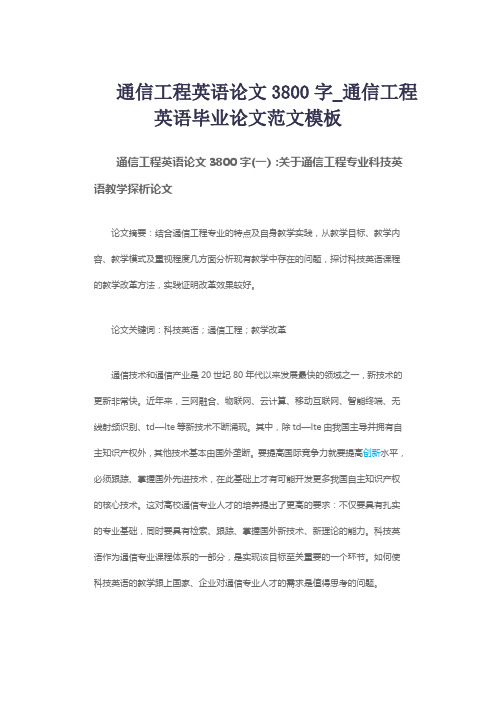
通信工程英语论文3800字_通信工程英语毕业论文范文模板通信工程英语论文3800字(一):关于通信工程专业科技英语教学探析论文论文摘要:结合通信工程专业的特点及自身教学实践,从教学目标、教学内容、教学模式及重视程度几方面分析现有教学中存在的问题,探讨科技英语课程的教学改革方法,实践证明改革效果较好。
论文关键词:科技英语;通信工程;教学改革通信技术和通信产业是20世纪80年代以来发展最快的领域之一,新技术的更新非常快。
近年来,三网融合、物联网、云计算、移动互联网、智能终端、无线射频识别、td—lte等新技术不断涌现。
其中,除td—lte由我国主导并拥有自主知识产权外,其他技术基本由国外垄断。
要提高国际竞争力就要提高创新水平,必须跟踪、掌握国外先进技术,在此基础上才有可能开发更多我国自主知识产权的核心技术。
这对高校通信专业人才的培养提出了更高的要求:不仅要具有扎实的专业基础,同时要具有检索、跟踪、掌握国外新技术、新理论的能力。
科技英语作为通信专业课程体系的一部分,是实现该目标至关重要的一个环节。
如何使科技英语的教学跟上国家、企业对通信专业人才的需求是值得思考的问题。
本文结合教学实践分析通信工程专业科技英语教学现状,针对存在的问题,提出了一些可行的教学改革方法。
一、教学现状分析1。
教学目标模糊科技英语是通信工程本科专业大学四年级开设的一门专业选修课,其教学目标为通过课文的精读,掌握基本的通信专业的英语词汇、科技英语的语言特点、句子特点和基本翻译技巧。
具备基本的查阅、翻译、理解本专业英语文献的能力,能够用英文进行基本的专业表达。
同时,也通过课文学习扩大学生的专业知识面,了解通信的基本技术、最新动向及新的英文专业术语。
这一目标对不同层次的高校没有进行明确的区分。
以应用型人才为培养目标的地方性本科、高职院校与以研究型人才为培养目标的重点高校的教学目标目差别不大,普遍存在各学校教学内容与教学模式千篇一律,互相之间照搬套用的现象。
关于OFDM技术的文献综述

文献综述题目:OFDM技术在低压电力线载波通信中的重要性OFDM技术在低压电力线载波通信中的重要性沈阳农业大学学士学位论文文献综述摘要:电力线载波通信,作为一种新的家庭宽带接入手段,近几年引起了人们极大的关注,宽带电力线正在成为走入家庭的第三条宽带线。
低压电力线载波通信技术由于涉及家庭自动化和家庭上网的良好前景而倍受瞩目。
但是电力线信道固有的噪声干扰、频率选择性衰减和多径传播特性大大影响了其通信性能。
而正交频分复用(OFDM)技术被认为是目前在具有频率选择性衰减特性通信环境中实现高速信号传输的主流技术,因此,基于OFDM技术的低压电力线载波通信是一个很有价值的研究课题。
本文在通过介绍OFDM技术的基本原理和实现的基础上,针对OFDM技术在低压电力线载波通信中的技术优势,以及如何利用以OFDM技术为主的交织编码技术来提高通信安全性的问题来阐述OFDM技术的重要性。
关键词:电力线载波通信;正交频分复用(OFDM);应用;重要性电力线载波是电力系统特有的通信方式,电力线载波通讯是指利用现有电力线,通过载波方式将模拟或数字信号进行高速传输的技术[1]。
最大特点是不需要重新架设网络,只要有电线,就能进行数据传递。
所以对于像我国这样幅员辽阔的国家来说,发展电力线电力线载波技术的意义非常重大。
随着信号处理等技术的发展,低压配电网载波通信被广泛认为是楼宇自动化、保安监控、办公自动化、远程抄表等领域替代专用网络的一种重要的数字通信方式[2]。
低压电力线载波通信在德、英、日等国家已取得了突破性的进展。
最早提出低压电力线载波通信概念并进行可行性研究的是英国曼彻斯特NORWEB供电公司,他们在完成世界上首次配电网上的25 个终端用户的电话与数据通信试验后(1992-1993),已开发出 2MHz 带宽内速率为1Mbps的系统.随后英国SWEB公司在电力线上开发提供包括水、天然气、电能自动抄表功能的系统[3]。
目前,美国Intellon公司开发出了基于扩频通信的SSC P300/P400系列芯片。
光通信必读优秀书籍

非线性光学部分介质在强激光场作用下产生的极化强度与入射辐射场强之间不再是线性关系,而是与场强的二次、三次以至于更高次项有关,这种关系称为非线性。
凡是与非线性有关的光学现象称为非线性光学现象,属于非线性光学的研究内容。
非线性光学一方面研究光辐射在非线性介质中传播时由于和介质的非线性相互作用自身所受的影响,另一方面则研究介质本身在光场作用下所表现出的特性。
在光通信中,主要是进入高速通信,10g,尤其是40G,随着入纤光功率的增强,非线性效应逐渐显现,系统设计必须加以考虑这方面的影响,于是在40G里面变出现了形形色色的编码。
以下切入正题1、《Nonlinear Fiber Optics》和《Applications of Nonlinear Fiber Optics》Agrawl ,这2本书从书名大家应该也可以看出是偏重于光纤通信应用的,目前第一个已经到第四版,第二个为第二版了,包括中译本,论坛都有,大家可以搜索下就可以都看到了。
... =nonlinear%2Boptics... =nonlinear%2Boptics2、Boyd 的《nonlinear optics》3rdW. Boyd教授在2002年被任命为Rochester大学 M. Parker Givens Professor of Optics,lz发的应该是第二版,该书1992年第一版,第二版在第一版的基础上增加了很多新内容,并对以前的内容做了不少修订,在2008年的4月,该书又出了第三版。
整体来说,该书内容比较深,学校里的高年级研究生和一般研究人员可参考。
今年5月份曾代表美国光学学会来南京开会下载链接:... =nonlinear%2Boptics3、华裔学者沈元镶的《非线性光学原理》沈是这方面非常牛b的,他的导师算是非线性光学方面的开创者吧,并因此获得了诺贝尔奖。
工作单位:美国伯克利加州大学简介:美国物理学家。
1956年毕业于台湾大学。
物联网英文文献
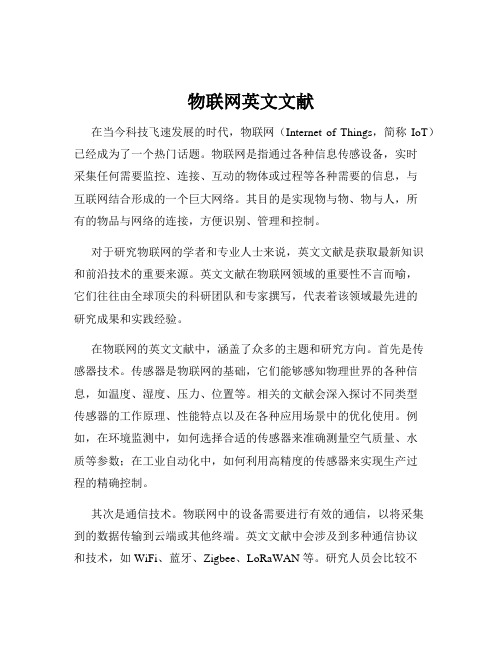
物联网英文文献在当今科技飞速发展的时代,物联网(Internet of Things,简称IoT)已经成为了一个热门话题。
物联网是指通过各种信息传感设备,实时采集任何需要监控、连接、互动的物体或过程等各种需要的信息,与互联网结合形成的一个巨大网络。
其目的是实现物与物、物与人,所有的物品与网络的连接,方便识别、管理和控制。
对于研究物联网的学者和专业人士来说,英文文献是获取最新知识和前沿技术的重要来源。
英文文献在物联网领域的重要性不言而喻,它们往往由全球顶尖的科研团队和专家撰写,代表着该领域最先进的研究成果和实践经验。
在物联网的英文文献中,涵盖了众多的主题和研究方向。
首先是传感器技术。
传感器是物联网的基础,它们能够感知物理世界的各种信息,如温度、湿度、压力、位置等。
相关的文献会深入探讨不同类型传感器的工作原理、性能特点以及在各种应用场景中的优化使用。
例如,在环境监测中,如何选择合适的传感器来准确测量空气质量、水质等参数;在工业自动化中,如何利用高精度的传感器来实现生产过程的精确控制。
其次是通信技术。
物联网中的设备需要进行有效的通信,以将采集到的数据传输到云端或其他终端。
英文文献中会涉及到多种通信协议和技术,如 WiFi、蓝牙、Zigbee、LoRaWAN 等。
研究人员会比较不同通信技术的优缺点,探讨如何在不同的应用场景中选择最合适的通信方式,以确保数据的可靠传输和低功耗运行。
数据处理和分析也是物联网英文文献中的重要内容。
随着物联网设备产生的数据量呈爆炸式增长,如何有效地处理和分析这些海量数据成为了关键问题。
文献中会介绍各种数据处理和分析的方法和算法,包括数据清洗、数据融合、机器学习算法在数据分析中的应用等。
例如,通过机器学习算法对智能家居中的用户行为数据进行分析,以实现个性化的智能控制;利用大数据分析技术对城市交通流量数据进行处理,以优化交通管理。
此外,物联网的安全和隐私问题也备受关注。
由于物联网设备通常连接到公共网络,存在着被黑客攻击和数据泄露的风险。
教育文本翻译相关文献
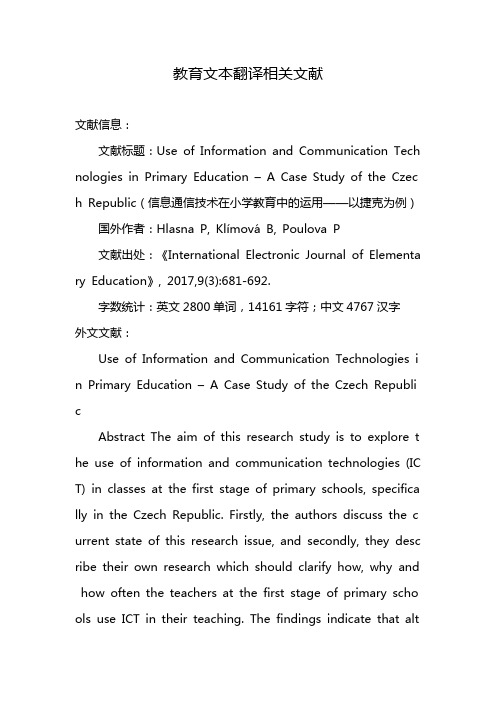
教育文本翻译相关文献文献信息:文献标题:Use of Information and Communication Tech nologies in Primary Education –A Case Study of the Czec h Republic(信息通信技术在小学教育中的运用——以捷克为例)国外作者:Hlasna P, KlímováB, Poulova P文献出处:《International Electronic Journal of Elementa ry Education》, 2017,9(3):681-692.字数统计:英文2800单词,14161字符;中文4767汉字外文文献:Use of Information and Communication Technologies i n Primary Education –A Case Study of the Czech Republi cAbstract The aim of this research study is to explore t he use of information and communication technologies (IC T) in classes at the first stage of primary schools, specifica lly in the Czech Republic. Firstly, the authors discuss the c urrent state of this research issue, and secondly, they desc ribe their own research which should clarify how, why and how often the teachers at the first stage of primary scho ols use ICT in their teaching. The findings indicate that although more than 50% of the teachers at primary schools use ICT in their teaching on a daily basis, they need furth er continuous methodological training which would contri bute to their effective use of ICT in classrooms. The result s also showed that the teachers who had participated in a methodological course on ICT use appeared to implemen t ICT in their classes more than those who had not atten ded such training. In addition, the results revealed that th e use of ICT was not influenced by the length of the teac hing practice and that the use of ICT still did not have an y impact on the relationship between the teacher and his/ her pupils and among pupils themselves. Nevertheless, the results suggest that there should be ample and continuo us trainings which would ensure that teachers have relevant competences for using ICT in their classroom s.Keywords: Education, Teachers, ICT, Primary schools, C ase studyIntroductionAt present, modern information and communication te chnologies (ICT) penetrate in all spheres of human activiti es, including education, in order to increase effectivenessand quality of teacher’s work. In fact, ICT are n ow an in separable part of children’s lives. They consider them as natural as breathing (Prensky, 2004). Therefore, schools at all educational levels try to incorporate them in their curri cula. Research connected with the use of ICT in education has already run for more than 40 years (cf. Baytak, Tarm an, &Ayas, 2011; Brdicka, 2003; Collins, 1996; Domingo & Gargante, 2015; Murphy et al., 2003). Research evidence r eveals that ICT have a positive impact on learning, especia lly in primary education (Badia et al., 2014; Inan & Lowthe r, 2010; or Van Braak et al., 2004).Frydrychova Klimova (20 12) lists several benefits of the use of ICT on learning, wh ich is also true for primary education:?learning concentrate s rather on the learner than a teacher;?learning becomes more personalized;?learning becomes on the one hand m ore independent, on the other more collaborative and inte ractive;?learning can happen at any place and any time;?le arning is enriched with more up-to-date materials, which can be tailored acco rding to students’immediate needs;? thanks to multimedia activities, learning becomes more va ried and dynamic;?learning requires critical thinking;?learni ng becomes more culture conscious.The importance, efficacy and usefulness of ICT in primary education have been also reflected in many cross-national and national compar ative research studies such as Computers in Education (CO MPED, 1989-1992), Second Information Technology in Edu cation Study (SITES, 2006), or Study of the Impact of Tech nology in Primary。
- 1、下载文档前请自行甄别文档内容的完整性,平台不提供额外的编辑、内容补充、找答案等附加服务。
- 2、"仅部分预览"的文档,不可在线预览部分如存在完整性等问题,可反馈申请退款(可完整预览的文档不适用该条件!)。
- 3、如文档侵犯您的权益,请联系客服反馈,我们会尽快为您处理(人工客服工作时间:9:00-18:30)。
通信技术类英文文献以下是一篇通信技术类英文文献,供参考:Title: 5G Wireless Communication: The Future of Communication TechnologyAbstract: The fifth-generation (5G) wireless communication is the next-generation technology, which is 100 times faster than the 4G technology and provides a higher bandwidth, low latency, and more reliable and secure communication. The 5G wireless communication aims to provide the flexibility of different services, including multimedia, cloud computing, internet of things (IoT), and virtual reality (VR). This paper provides an overview of the5G wireless communication technology, including its features, architecture, and its applications.Introduction: The rapid growth of wireless communication technology has brought significant changes in the way people interact with each other. The 5G wireless communication technology is the revolutionary technology that aims to provide a higher level of communication, which is 100 times faster than the 4G technology. The 5G wireless communication is expected to be the future of communication technology, which will change the way people interact with each other.Features of 5G Wireless Communication:The 5G wireless communication has various features that provide a higher level of communication. These features are:1. High Bandwidth: The 5G wireless communication provides a high bandwidth, which increases the data transfer rate. This high bandwidth provides a better experience for multimedia services, such as streaming video, music, and gaming.2. Low Latency: The 5G wireless communication provides a lower latency, which improves the response time of the communication. This low latency is ideal for real-time applications such as autonomous vehicles, AR/VR, and remote surgeries.3. Massive IoT: The 5G wireless communication supports a large number of IoT devices with a higher density of devices per unit area. This feature enables the functionality of IoT applications in various industries, such as smart homes, smart cities, and healthcare.4. Network Slicing: The 5G wireless communication provides network slicing, which enables the partitioning of the network into multiple virtual networks. This feature provides the flexibility to provide different services with different requirements such as high speed, low latency, and high reliability.5. Security: The 5G wireless communication provides a higher level of security for communication. This security is provided through various features such as authentication, encryption, and privacy.Architecture of 5G Wireless Communication:The 5G wireless communication has a different architecture thanthe previous generations of wireless communication technology. The architecture of the 5G wireless communication is divided into three layers: the user plane, the control plane, and the management plane.1. User Plane: The user plane is responsible for the transmission and reception of user data. This layer involves the transmission and reception of user data through the radio access network (RAN) and the core network.2. Control Plane: The control plane is responsible for controlling the signaling messages between the user equipment (UE) and the network. This layer involves the control of signaling messages related to call setup, call tear down, and mobility management.3. Management Plane: The management plane is responsible for the management of the network resources and the configuration of the network. This layer includes the management of the network functions such as orchestration, automation, and telemetry.Applications of 5G Wireless Communication:The 5G wireless communication has various applications, which will have a significant impact on different industries. Some of the applications are:1. Smart City: The 5G wireless communication enables the functionality of smart city applications such as smart transport, smart parking, and smart street lighting.2. Healthcare: The 5G wireless communication provides a higher level of healthcare with the use of various applications such as telemedicine, remote surgery, and health monitoring.3. Industrial Internet of Things (IIoT): The 5G wireless communication enables the functionality of IIoT applications such as predictive maintenance, asset tracking, and real-time manufacturing process monitoring.4. Agriculture: The 5G wireless communication provides the functionality of precision agriculture applications such as intelligent irrigation, crop monitoring, and farm automation.Conclusion:The 5G wireless communication is the next-generation technology, which is expected to be the future of communication technology. The 5G wireless communication provides a higher level of communication with its features such as high bandwidth, low latency, and massive IoT. The implementation of the 5G wireless communication will have a significant impact on different industries such as healthcare, smart city, and IIoT.。
